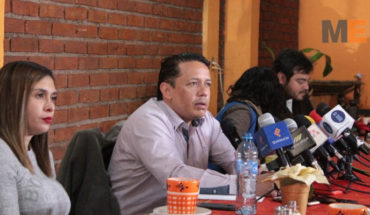The Coneval presented on December 10 its Social Rights Information System in which it records information on effective access to education, health, food, housing and social security. The findings show that coverage of services linked to these areas has grown in Mexico, but that does not mean that they are provided with sufficiency and quality.
In education, between 2010 and 2018, the percentage of the population aged 15 to 21 that attended the upper average level increased by almost seven percentage points, from 56.1% to 62.8%.
However, “while the educational lag has declined in the country, the quality of education still shows wide margins for improvement,” said José Nabor Cruz, executive secretary of the National Council for the Evaluation of Social Development Policy (Coneval), during the presentation of the System.
According to the PLANEA test, in 2017 third graders with satisfactory or outstanding levels in field mastery such as Language and Communication or Mathematics were low (26.1% and 13.7%).
Read: Women, Indians, LGBTI people and older adults have the worst wages in Mexico
These results demonstrate the need to redouble efforts in pedagogical matters, as well as to continue generating information that allows to account for the quality of learning in the country.
Meanwhile in health, between 2010 and 2018, the percentage of the population that gained access to medical services increased from 70.8% to 83.8%.
But, Nabor Cruz explained, membership in services or programs is not sufficient condition.
In 2018, for example, less than half of the eligible population (47.8%) received preventive services related to chronic-degenerative conditions in public institutions, a basic service that is the obligation of the State to provide.
Social security systems, for their part, play a key role in generating equal opportunities and well-being at different points in people’s life. For the population of children and adolescents, the percentage of people with access to social protection mechanisms stood at 35.9% in 2010 and increased slightly to 38.9% in 2018.
However, last year, only three out of ten people aged 65 and over received a retirement or pension (contributory or non-contributory) for an amount equal to or greater than the average value of the income poverty line (equivalent to the cost of the food and non-food basket). Although this indicator is expected to improve the following year with the pensions for older adults set in motion by the current federal administration.
With regard to the right to food, the percentage of the population living in households with food security where, in addition, a diverse diet is consumed, improved by three percentage points between 2014 and 2018.
Read: Drug Deaplet Hits Diabetes, Hypertension and Cancer Sufferers More
Despite this, in 2016, about three in ten people aged 20 and over were overweight or obese, the main modifiable risk factor for the development of chronic noncommunicable diseases, such as diabetes mellitus, cardiovascular disease and certain cancers.
The information suggests the urgency of improving people’s access to quality diets and health services, as well as ensuring that access is distributed equitably among all household members.
While the percentage of the population with access to basic housing services in 2018 was 80.2%, and there was even an improvement from 2010, (77.1%), “only half of the population has the availability of water in the house every day,” Nabor Cruz said, and this situation showed no change between 2010 and 2018 (from 52.5% to 53.6%, respectively). These indices reflect the need to join efforts from public policy on accessibility to basic housing services.
As for priority groups, “indigenous women are over-represented in the poorest income decile, on the contrary only 2 in 100 are in the wealthiest income decile,” coneval’s executive secretary revealed.
In 2018, 75.3% of rural indigenous women lived in homes without access to intubated water or where they are cooked with firewood or coal, without having a fireplace. This affected 6.5% of non-indigenous women living in the city. The gap (68.8 percentage points) clearly reflects the accumulation of disadvantages to which they are exposed, not only because of their membership in an ethnic group, but also because of their place of residence.
Among older women only 2 in 10 received a contributory pension, as a result of their low participation in the formal labour market, as well as the career paths interrupted by domestic, parent-up and childcare work.
Regarding the population with disabilities, in 2018, while 69.4% of the non-disabled population did some economic activity, only 39.8% of the population with some disability did so. This difference, of almost 30 percentage points, makes the exclusion of one of the most important spaces of social participation for its development, since work not only provides income, but opportunities for socialization, learning and self-esteem.
Find out: Poorest Mexicans spend 61% of their income on housing pay
In the case of young people, this group faces precarious working conditions, in 2018 only 4 out of 10 urban young people employed had access to social security work benefits. This situation is exacerbated for young people living in rural areas, as only 15.1% received this benefit from their employer.
The Coneval information system also shows the gaps by state. In the national total, only 49.9% of the population has housing with sufficient spaces, i.e. exclusive spaces for sleeping or cooking and without overcrowding. A low percentage that worsens in Chiapas, Michoacán, Puebla and Guerrero, where the population in homes with these characteristics is less than 27%.
Nationally, the percentage of households consuming fruits and vegetables daily reached just 21.1%. The situation is more serious in entities such as Guerrero, Chiapas, Yucatan, Tabasco, Campeche, Veracruz and Oaxaca, where this percentage was less than 13%.
In this initial phase, the System consists of 139 indicators divided into two components: the first is effective access to education, health, social security, food and housing, with 47 indicators and disaggregation at the federal entity level.
The second component is inequality gaps in specific population groups. It has 92 indicators, at the national level, that make visible the gaps in the exercise of rights between historically disadvantaged population groups, such as indigenous women, young population (12 to 29 years), older adult population (65 years and older) and population with some disability.
In a second phase, the System will have indicators related to the right to work, the healthy environment and non-discrimination.
What we do in Animal Político requires professional journalists, teamwork, dialogue with readers and something very important: independence. You can help us keep going. Be part of the team.
Subscribe to Animal Politician, receive benefits and support free journalism.#YoSoyAnimal
translated from Spanish: Mexico, failed in effective access to social rights: Coneval
December 11, 2019 |





